
The blue whale is a marine mammal belonging to the baleen whale suborder Mysticeti. Reaching a maximum confirmed length of 29.9 meters and weight of 173 tonnes, it is the largest animal known to have ever existed. The blue whale's long and slender body can be various shades of grayish-blue dorsally and somewhat lighter underneath.

Amphipoda is an order of malacostracan crustaceans with no carapace and generally with laterally compressed bodies. Amphipods range in size from 1 to 340 millimetres and are mostly detritivores or scavengers. There are more than 9,900 amphipod species so far described. They are mostly marine animals, but are found in almost all aquatic environments. Some 1,900 species live in fresh water, and the order also includes terrestrial animals and sandhoppers such as Talitrus saltator.

Isopoda is an order of crustaceans that includes woodlice and their relatives. Isopods live in the sea, in fresh water, or on land. All have rigid, segmented exoskeletons, two pairs of antennae, seven pairs of jointed limbs on the thorax, and five pairs of branching appendages on the abdomen that are used in respiration. Females brood their young in a pouch under their thorax.
Monoporeia affinis, formerly referred to as Pontoporeia affinis, is a small, yellowish benthic amphipod living in the Baltic Sea, the Arctic Sea and the lakes of the Nordic Countries.

Talitridae is a family of amphipods. Terrestrial species are often referred to as landhoppers and beach dwellers are called sandhoppers or sand fleas. The name sand flea is misleading, though, because these talitrid amphipods do not bite people.

The Mediterranean rainbow wrasse is a small, colourful fish in the family Labridae. It can be found in the Mediterranean Sea and in the northeast Atlantic Ocean from Sweden to Senegal. Records of this species south from Senegal and the Cape Verde Islands are actually the closely related Coris atlantica.
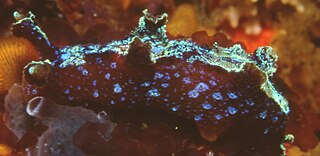
The iridescent nudibranch, Notobryon sp, is an undescribed species of scyllid nudibranch, and is found in South Africa. It is a marine gastropod mollusc in the family Scyllaeidae.

The Mediterranean mussel is a species of bivalve, a marine mollusc in the family Mytilidae. It is an invasive species in many parts of the world, and also an object of aquaculture.
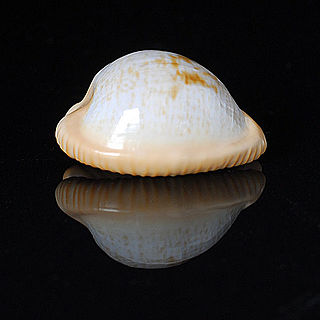
Cypraeovula fuscodentata is a species of medium-sized sea snail, a predatory marine gastropod mollusc in the family Cypraeidae, the cowries.
The orange hairy chiton, Chaetopleura pertusa, is a species of chitons in the family Chaetopleuridae. It is a marine mollusc. It is endemic to South Africa.

Leucothoe incisa is an amphipod in the family Leucothoidae. It grows up to 7 millimetres (0.28 in) long, and is whitish in colour, but a yellowish green along the back, with intensely red eyes. It lives at depths of up to 60 metres (200 ft) along the Atlantic coast of Europe from the Mediterranean Sea to Scotland, and in the North Sea. It is part of group of sibling species, together with Leucothoe lilljeborgi and Leucothoe occulta.

Clinus acuminatus, the sad klipfish, is a species of fish in the family Clinidae. It is endemic to Southern Africa, where it occurs along the coast of Namibia and South Africa. It can reach a maximum length of 13 centimetres (5.1 in) TL and is viviparous. The sad klipfish feeds on crustaceans.
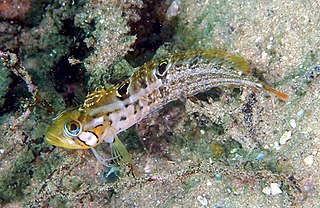
Clinus venustris, the speckled klipfish, is a species of clinid that occurs in subtropical waters of the Atlantic Ocean from Namibia to South Africa where it is found in the subtidal zone as well as being a denizen of tide pools. This species can reach a maximum length of 12 centimetres (4.7 in) TL. and feeds primarily on amphipods, isopods, mysids, and echinoderms.

Caprella mutica, commonly known as the Japanese skeleton shrimp, is a species of skeleton shrimp. They are relatively large caprellids, reaching a maximum length of 50 mm (2.0 in). They are sexually dimorphic, with the males usually being much larger than the females. They are characterized by their "hairy" first and second thoracic segments and the rows of spines on their bodies. Body color ranges from green to red to blue, depending on the environment. They are omnivorous highly adaptable opportunistic feeders. In turn, they provide a valuable food source for fish, crabs, and other larger predators. They are usually found in dense colonies attached to submerged man-made structures, floating seaweed, and other organisms.
Aulacomya atra, called also the Magellan mussel or the ribbed mussel, is a southern species of edible saltwater mussel, a marine bivalve mollusk in the family Mytilidae, the true mussels. Note that the common name ribbed mussel is also used of the Northern Hemisphere mussel Geukensia demissa.

Sabella spallanzanii is a species of marine polychaete worms in the family Sabellidae. Common names include the Mediterranean fanworm, the feather duster worm, the European fan worm and the pencil worm. It is native to shallow waters in the northeastern Atlantic Ocean and the Mediterranean Sea. It has spread to various other parts of the world and is included on the Global Invasive Species Database.
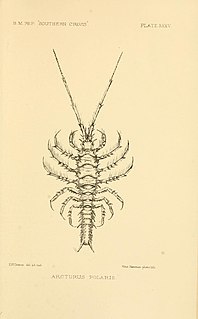
Elsie Wilkins Sexton was an English zoologist and biological illustrator.
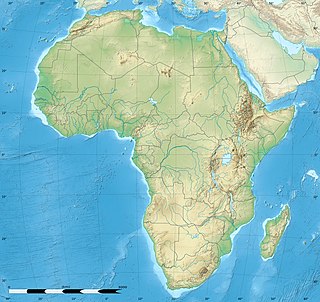
The Agulhas Bank Complex Marine Protected Area is an offshore marine protected area on the continental shelf lying approximately 39 nautical miles southeast of Cape Agulhas off the Western Cape in the Exclusive Economic Zone of South Africa.

The Marine biodiversity of South Africa is the variety of living organisms that live in the seas off the coast of South Africa. It includes genetic, species and ecosystems biodiversity in a range of habitats spread over a range of ecologically varied regions, influenced by the geomorphology of the seabed and circulation of major and local water masses, which distribute both living organisms and nutrients in complex and time-variable patterns.
















